Review: using Apple’s AirTag for tracking checked luggage
Could Apple’s AirTags be the hottest travel accessory since noise-cancelling headphones? We headed to the airport to find out.
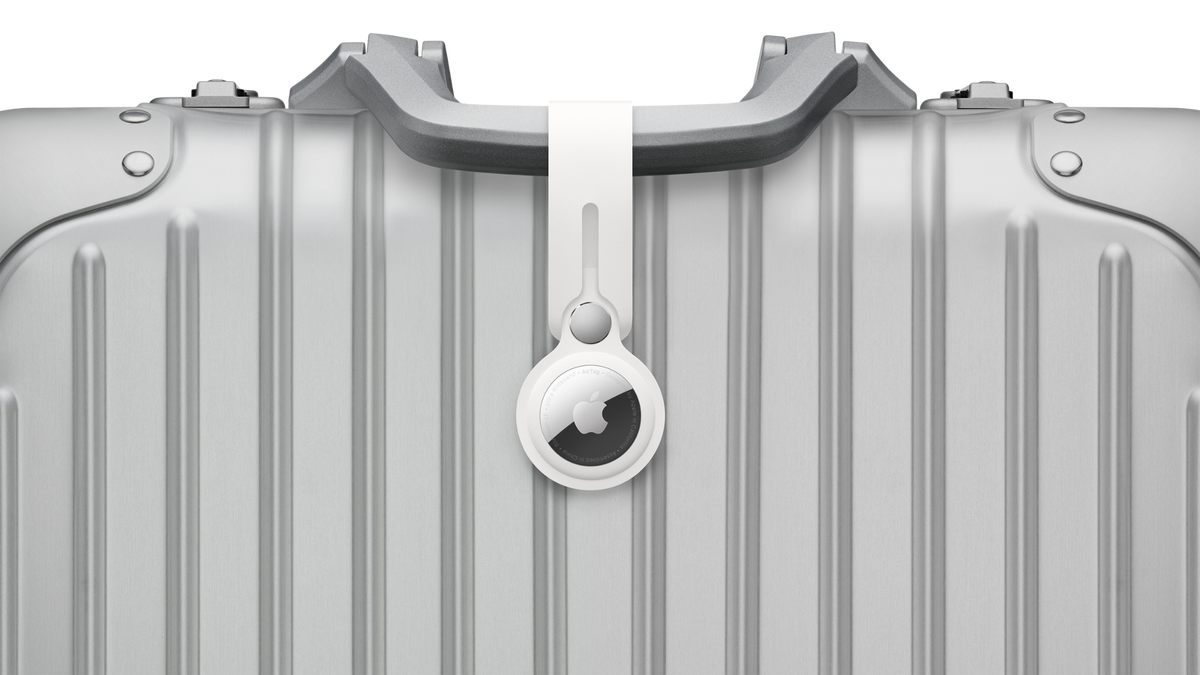
When Apple unveiled its new AirTag tracker, my thoughts immediately went to how useful this button-sized device could be for frequent flyers travelling with checked luggage.
After all, using the AirTag to keep tabs on everyday items ranging from backpacks and suitcases to expensive jackets, an umbrella, purse or your car keys is a given. If you lose it, an AirTag can track it and help you find it again.
But we’ve all stood around airport luggage carousels, waiting for bags to be disgorged from the chute and then make their way along that snaking conveyor belt to wherever we’re standing.
Could Apple’s newest gadget be the hottest travel accessory since noise-cancelling headphones?
Executive Traveller headed to the airport with AirTagged luggage in tow to find out.
Apple AirTag 101
If you’re not up to speed on the Apple AirTag, here’s a quick recap.
The size of a 20c piece and the shape of a coat button, AirTags are wireless gizmos which can be attached to anything you’re likely to temporarily misplace, leave behind or full-on lose.
Powered by a replaceable CR2032 coin battery, each AirTag is constantly broadcasting a silent, sonar-like Bluetooth ping.
(There’s no ‘off’ switch: the AirTag springs to life as soon as you insert the battery, which lasts for a year and alerts you when it’s running low.)
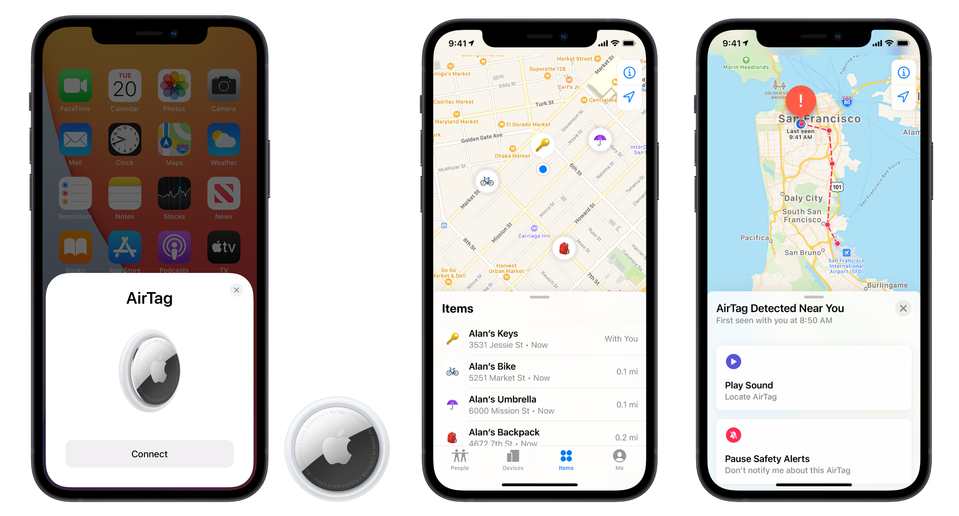
If an AirTag is within Bluetooth range of your iPhone, iPad or even Apple laptop or desktop – which usually means the AirTag is somewhere in your house – its location will appear in Apple’s Find My software (which can already be used to locate iPhones, iPads, AirPods and what-not) to help you find it.
In fact, if you’ve got an iPhone 11 or 12 series and are even closer to your missing item (what’s known in Hide and Seek as ‘getting warm’), your iPhone will switch to Precision Finding mode and guide you to the AirTag by accurately reporting both distance and direction.
This relies on Ultra Wideband technology, enabled by these iPhones and the AirTags both containing Apple’s special U1 microchip. It’s dead clever stuff.
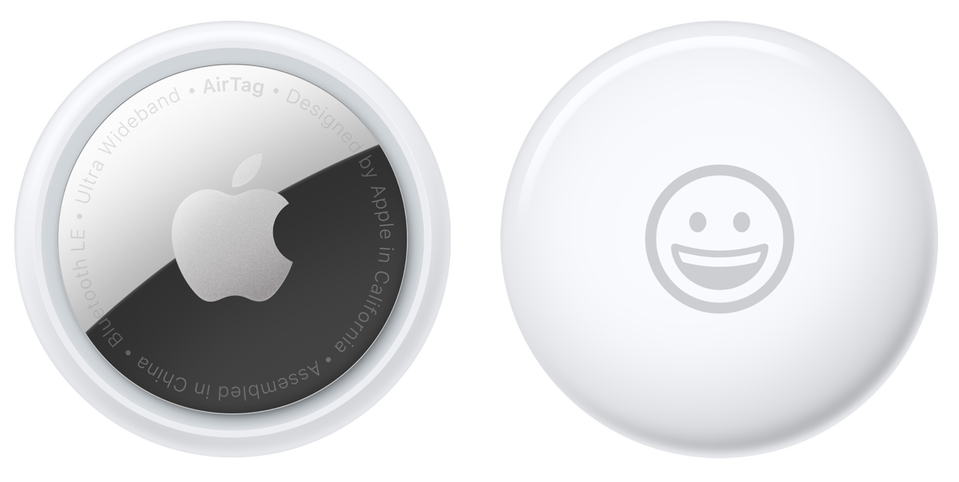
What if your gear has wandered much further afield?
Any of the billion-plus other devices in Apple’s cloud-based Find My network – other people’s iPhones, iPads etc – can pick up the Bluetooth signal from any nearby AirTag and privately relay its location back to the owner.
Because the Find My software is baked into Apple’s operating systems and usually always active, this happens automatically: Apple is, in effect, crowd-sourcing an ever-vigilant global search party.
You can even flag an AirTagged item as ‘lost’ so that you get a location alert when it surfaces while the AirTag itself can communicate a contact phone number and message to any Apple user or even Android smartphone user (using NFC) who stumbles upon it.
AirTags are predictably sleek – shiny stainless steel on one side, glossy white on the other (this surface can be customised with laser-etching) and not outrageously priced, at $45 each or $149 for a pack of four, although if you want to attach the AirTag to something you’ll need a cost-extra key ring, loop strap or holder (starting at $20).
The AirTag goes head-to-head with similar trackers such as Tile and Samsung’s SmartTag, but it’s an obvious choice for anybody already in the Apple ecosystem, and cleverly taps into the massive size of the Apple device market.
Using Apple’s AirTag for airline luggage
Now let’s get down to the travel-centric nitty-gritty.
You’re off on yet another flight – hopefully a holiday, although it’s probably work – and you decide to attach an Apple AirTag to each checked bag.
Put a new AirTag next to your iPhone and it’s automatically and elegantly paired to your iPhone (and your Apple iCloud account, which is the backbone of the Find My network), just like AirPods.
To describe what the AirTag is tracking, choose from a list of suggested names – each accompanied by a preset icon – or give it a unique name and choose an icon to suit.
(Of course, you can easily change an AirTag’s name and icon if you need to move it from one device to the another.)
Attach that AirTag to your luggage, head to the airport and drop off your checked bags as usual.
Obvious question #1: the AirTag is continually transmitting little Bluetooth burps, but don’t airlines want Bluetooth gadgets disabled during flight?
Other luggage trackers such as Tile have been doing the same thing for years, while passengers have wireless Bluetooth headphones and earphones, so this is really not an issue.
Also worth noting: while airlines have banned rechargeable lithium-ion battery packs from checked luggage (including so-called ‘smart luggage’), this doesn’t apply to the tiny single-use lithium CR2032 cells. Besides which, they’re already in millions of Tiles and key fobs sitting in cargo holds.
Putting Apple’s AirTag to the test
Here, then, is the scenario: you step off your flight and head to a carousel that’s already packed with luggage, with more bags being disgorged by the minute.
But this time your bag has had a high-tech upgrade, courtesy of the AirTag dangling from the handle or more subtly snugged into a side pocket.
Instead of trying to peer over and through the crowd, watching for your luggage to appear, you just stand back – maybe even grab a seat – launch your iPhone’s Find My app and wait for your AirTagged bag to make its presence known.
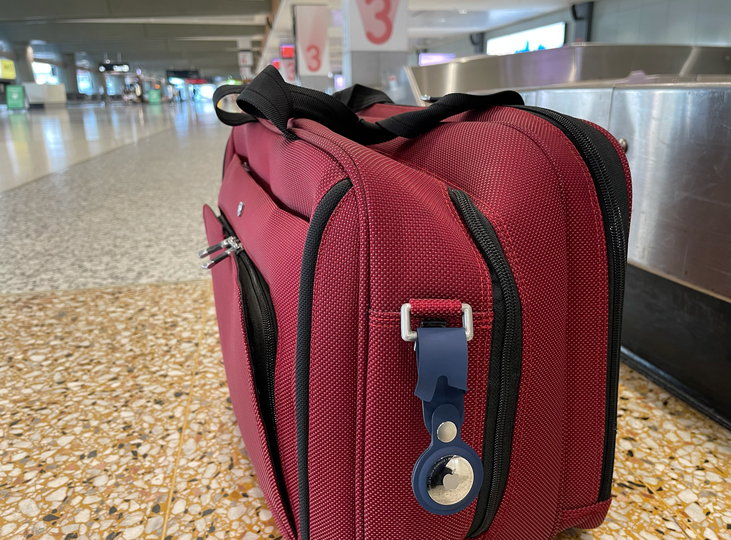
Here’s the bad news: having thoroughly tested the AirTag at an airport, we can report this is not what happens. In this scenario, Apple’s AirTag simply doesn’t work.
The first issue is that the AirTag’s live here-I-am tracking isn’t intended for objects that are moving, unless they’re doing so at the most leisurely pace.
And while the average airport luggage belt is no threat to Usain Bolt, it runs too fast for the AirTag’s virtual hand-waving to be properly identified by your iPhone.
(During my AirTag media briefing earlier in the week, Apple had suggested this might be the case: although to its credit the Find My app was aware the luggage was moving.)
Even with an iPhone 12 to take advantage of Precision Finding, the only time the AirTagged bag appeared on my screen while being carried along the belt was when it was literally right in front of me.
Of course, if you’re standing at the edge of the luggage belt then you’ll see your bag before anything else; and if you’re stuck behind a three-people deep throng of fellow travellers, you may still spy the bag but the iPhone certainly won’t see it.
What about using all that congestion in your favour? While those plane-loads of passengers are catching up with email and texts and social media on their iPhones, can their combined input to Apple’s Find My network at least show if your bag’s on the carousel?
Again, no. Pinpointing very specific locations on the Find My screen relies on Apple Maps, which simply doesn’t drill down to such a granular level, and certainly not deep inside an airport terminal.
What the AirTag might be able to do – if Apple's willing to entertain this in a future software update – would be to send a notification to your iPhone once it comes within Bluetooth range, such as when your bag lands on the carousel.
This is less complicated than actual device tracking but would still be immensely useful for travellers.
Where the AirTag works like a travel charm
So does this mean that Apple’s AirTag is a total fail for the frequent flyer? Far from it.
AirTags have a clear application to help find anything you might travel with but also risk leaving behind or losing: your passport wallet, a briefcase or jacket, even the carry case where your noise-cancelling headphones reside when not in use (there’s a reason noise-cancelling cans are among the most numerous items when airports auction off their lost property).
And there are other times when an AirTag will come to the rescue of your checked luggage.
During peak periods, airport staff can move bags from one flight – even if it’s only recently landed – off the luggage belt as bags from another flight pour in. You finally get through the customs and immigration checkpoint, reach the carousel and waste a half-hour waiting to see your bag on the belt before discovering it’s been sitting in that corral over there.
There’s a good chance the Find My app – especially with Precision Finding – could help show where your bag really is, given that it’s stationary rather than on a moving belt.
In our testing, the iPhone 12 identified and gave clear directions to an AirTagged bag almost 10 metres away (putting the AirTag inside the bag instead of on the external strap made no discernible difference to the range or accuracy of tracking).
Likewise, when a large bag checked in for your flight is unexpectedly directed to the oversized baggage office instead of coming out on the luggage belt, an AirTag could save you plenty of time and frustration.
Another example: a colleague recounted how, on arriving on a flight from Los Angeles to Sydney, her bag failed to appear on the belt, and she was eventually told her bag was in fact among many which were not loaded at LAX.
That turned out not be the case – all the bags had made it to Sydney Airport – and a quick check of the Find My app would have shown they were somewhere in the vicinity rather than 12,000km away.
The take-away? While Apple’s AirTags won’t solve all of your baggage belt blues, they’re still going to find a very welcome place in your travel kit.
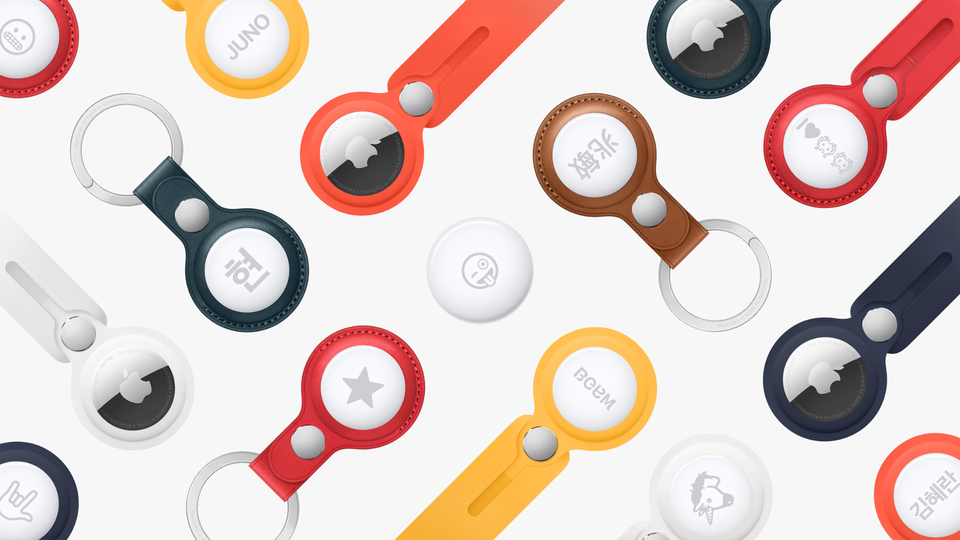
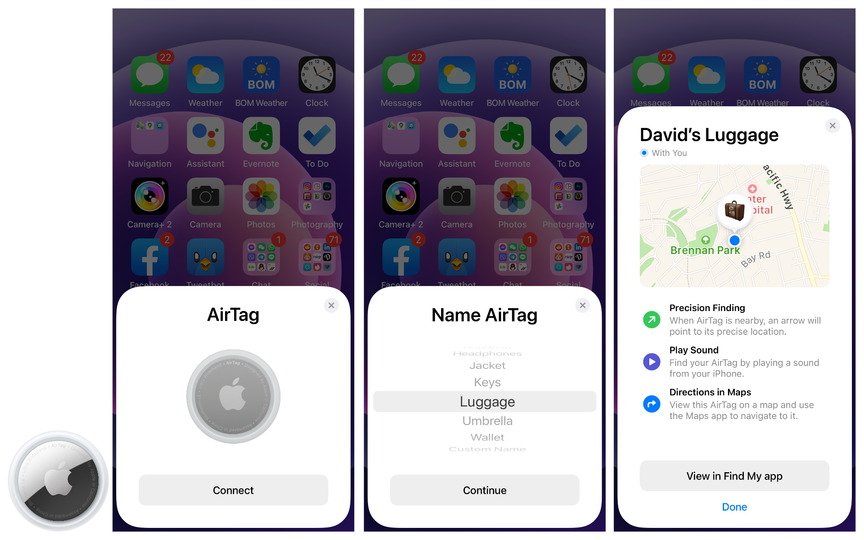
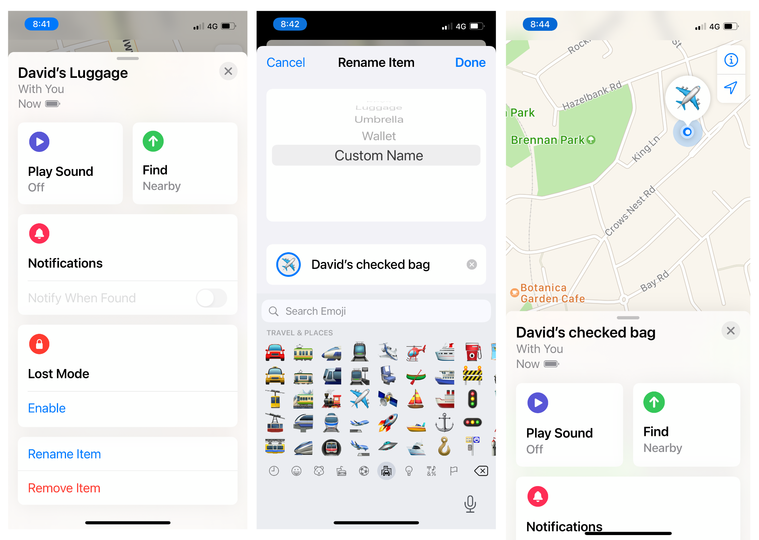
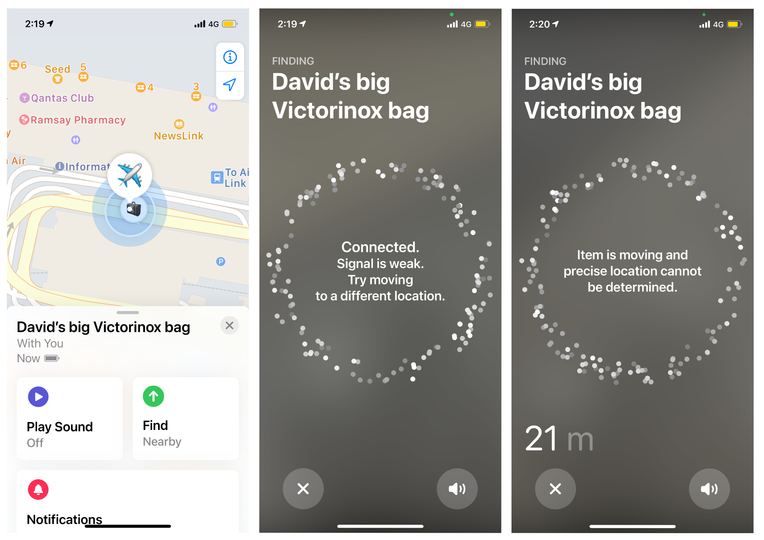
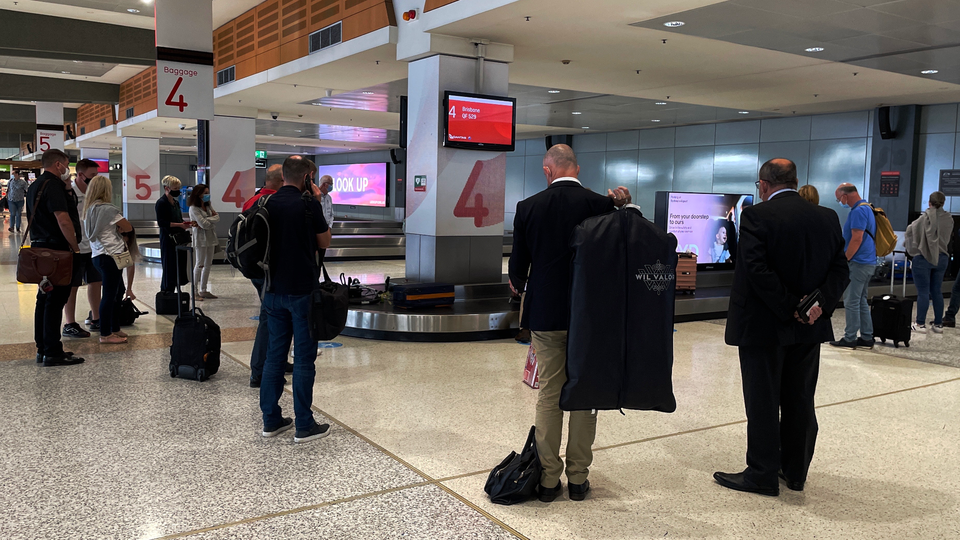
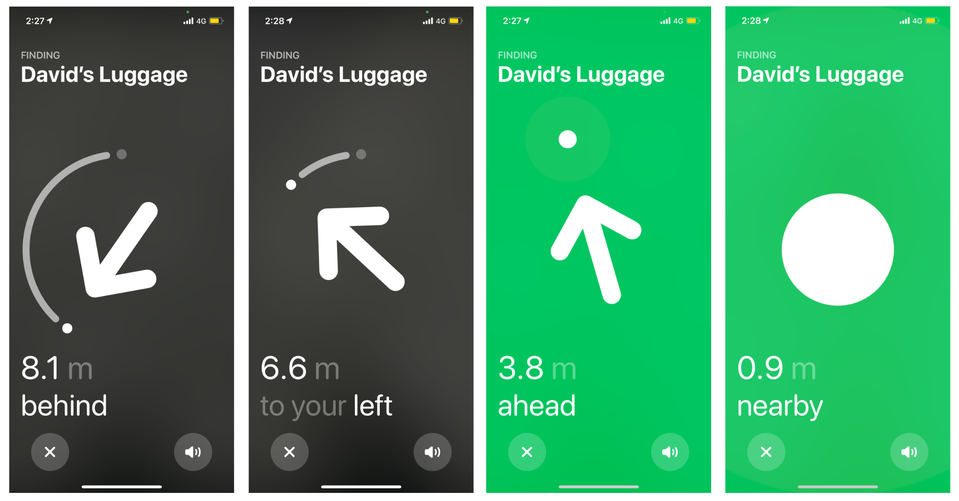

Qantas - Qantas Frequent Flyer
05 Apr 2012
Total posts 57
Look good & was going to buy one at Apple Brisbane - $45 for a 'test one was great .. but $50 for the tag holder ... as you said David "Ironically, most AirTag holders cost more than the AirTag itself" . any after market ones ?
08 Apr 2021
Total posts 4
Belkin and Namad are making some. Hermès too if you are very keen 😁
20 Nov 2015
Total posts 485
There'll be a lot of non-Apple AirTag accessories coming out now that the device itself has been released. You can also see a lot on Amazon as well as from brands like Belkin, Nomad, Spigen and Caseology. And if you go to Etsy there are sure to be a lot more and an very low priced. I'd just be wary of buying anything from the sort of no-names on Etsy too soon because the whole purpose of these things is to hold your AirTag on a bag or keys or something that will be in motion, and if the AirTag doesn't fit well or securely into the holder and it falls out during all that movement, then you've lost a $45 AirTag for the sake of saving some money on a holder.
My point is that there's no guarantee that the first batch of accessories from the Etsy crowd will have a really proper fit because the AirTag has just come out, obviously bigger and more respectable brands will have been given the specs and dummy units by Apple in advance so they can begin manufacturing their own accessories. So if you buy an AirTag very soon but want something cheaper than the Apple holders I would stick with the likes of Belkin etc, or allow more time for the Etsy crowd to get their designs right.
05 Mar 2015
Total posts 421
Great review David, I always enjoy seeing actual 'hands-on' testing like this. I had the same sort of idea as you, "Wouldn't it be great to have my iPhone receive an alert from the AirTag when it's within range?". I'm sure Apple will add this down the track because it would be very smart and also pretty easy to do, just let the user set that particular tag to notify you as the owner when it comes back within range after going our of range for more than X hours.
Anyway, the other scenarios such as bags being offloaded next to the belt or not even being in the same city as you would be good instances for the AirTag along with the usual ways Apple has been selling it, so I will probably buy a set of four, but when it comes to holders I will go shopping on Amazon and Etsy and Ebay, as Apple only has a few designs as well as them being very expensive. The third-party market will have so many different designs and styles to choose from and at more sensible prices too.
08 Apr 2021
Total posts 4
Great review like always! I wonder how it will compare to the Tile Pro?
I use the Tile Pro on the check-in luggage to check that it has made its way onboard at the start of the journey, and to see it when it’s close to/on the carrousel. The range is great! The only time when I couldn’t see my tile on the plane is when I was on the upper deck of the a380 (regrettably it doesn’t happen often enough). I wonder if the Airtag will have similar ramge?
20 Nov 2015
Total posts 485
What a fantastic review, loved seeing the 'travel' focus in this too, very smart way for ET to do tech. Happily I tend not to lose things, well happy for me but not for Apple, so I like the idea of the AirTag but it's not for me at the moment. But if Apple added that 'your bag is near' alert like suggested, so my iPhone would buzz or vibrate when the bag comes within Bluetooth range on the luggage belt, I'd probably go right out and buy a few.
20 Oct 2015
Total posts 254
A great review and a great read. I was on the fence about these AirTags because I was hoping they would do what you describe, ie alert me when my bags come out, but having read this review I will still buy a set of four because it's clear they can work very well in other situations with bags as well as the more normal uses Apple has outlined. But I don't think I would trust that Apple strap, there's just too much chance of it being caught in the belt machinery and ripped off. I will be looking for a very short AirTag holder which keeps the AirTag very close to the bag or on the handle, or I will put the AirTag inside the bag and not even advertise its presence.
01 Nov 2018
Total posts 81
To my understanding Samsung also make these as well for those who use Samsung Galaxy phones, how they perform I honestly don't know. Also not sure if their available here in Australia. Just Google Samsung Galaxy Smart Tag +
Qantas - Qantas Frequent Flyer
26 May 2014
Total posts 12
Also could be useful for those times that your suitcase (albeit orange hardcase and usually rather unique on the carousel!) might be taken away by another traveller who can’t recognise their own bag or fails to read the incorrect name on the tag - and then they leave the customs area with your bag, leaving theirs behind for you to sadly check and confirm to staff that it’s not yours after all ☹️☹️😫.
19 Sep 2023
Total posts 2
Thank you for the fantastic article with details on limitations of AIr Tag. I have been using this for last 12+ months and it is a good tool to first confirm that the Air line has not sent your bag a wrong destination or left at some un-known place. Specially valuable if you are flying through a transit location.
Yes, it may not tell you that it is coming towards you but it will tell you that the bag is nearby or or reached the belt area. That is helpful as we do not have to stand next to the belt blocking everyone until it reaches the belt. But my advice is to have the tag inside the bag as it might get unwanted attention if it is visible.
But definitely good to have tool if you an Apple user. Previously I had Tile but it did not provide me any such update like Air Tag. It will relay the location through other Apple devices.
19 Sep 2023
Total posts 2
Another scenario is what Andrew1970 has indicated. Amazing to see how this unit communicate with you through other devices. Certainly recommend using Air Tags. I have used a different tag previously but I did not get any location update like what I get from Air Tags. I would not recommend having the tag outside of your bag unless it is a hand carried bag. If you attach the tag outside so that it is visible it might even attract un-wanted interest specially in certain parts of the world.
Hi Guest, join in the discussion on Review: using Apple’s AirTag for tracking checked luggage